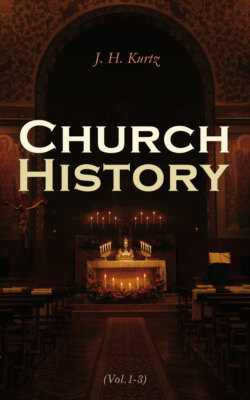Читать книгу Church History (Vol.1-3) - J. H. Kurtz - Страница 23
На сайте Литреса книга снята с продажи.
ОглавлениеFIRST DIVISION.
History of the Development of the Church during the Græco-Roman and Græco-Byzantine Periods.
Table of Contents
§ 19. Content, Distribution and Boundaries of those Periods.
At the very beginning of the Apostolic Age the universalistic spirit of Christianity had already broken through the particularistic limitations of Judaism. When once the substantial truth of divine salvation had cast off the Judaistic husk in which the kernel had ripened, those elements of culture which had come to maturity in the Roman-Greek world were appropriated as means for giving to Christian ideas a fuller and clearer expression. The task now to be undertaken was the development of Christianity on the lines of Græco-Roman culture, or the expansion of the church’s apostolicity into catholicity. The ancient church of the Roman and Byzantine world fulfilled this task, but in doing so the sound evangelical catholic development encountered at every point elements of a false, because an unevangelical, Catholicism. The centre, then, of all the movements of Church History is to be found in the Teutono-Roman-Slavic empire. The Roman church preserved and increased her importance by attaching herself to this new empire, and undertaking its spiritual formation and education. The Byzantine church, on the other hand, falling into a state of inward stagnation, and pressed from without by the forces of Islam, passes into decay as a national church.
The history of this first stage of the development of the church falls into three periods. The first period reaches down to Constantine the Great, who, in A.D. 323, secured to Christianity and the church a final victory over Paganism. The second period brings us down to the close of the universal catholic or œcumenical elaboration of doctrine attained by the church under its old classical form of culture, that is, down to the close of the Monothelite controversy (§ 52, 8), by the Sixth Œcumenical Council at Constantinople in A.D. 680. But inasmuch as the Concilium quini-sextum in A.D. 692 undertook simply the completion of the work of the two previous œcumenical synods with reference to church constitution and worship, and as here the first grounds were laid for the great partition of the church into Eastern and Western (§ 63, 2), we prefer to make A.D. 692 the closing limit of the second period. The conclusion of the third period, is found in the overthrow of Constantinople by the Turks in A.D. 1453. The first two periods are most evidently distinguished from one another in respect of the outward condition of the church. Before the times of Constantine, it lives and develops its strength amid the oppression and persecution of the pagan state; under Constantine the state itself becomes Christian and the church enjoys all the advantages, all the care and furtherance, that earthly protection can afford. Along with all this worldly splendour, however, a worldly disposition makes its way into the church, and in exchange for its protection of the church the state assumes an autocratic lordship over it. Even in the inner, and pre-eminently doctrinal, development of the church the two periods of this age are essentially distinguished from one another. While it was the church’s endeavour to adopt only the forms of culture of ancient paganism, while rejecting its godless substance, it too often happened that pagan ideas got mixed up with Christianity, and it was threatened with a similar danger from the side of Judaism. It was therefore the special task of the church during the first period to resist the encroachment of anti-Christian Jewish and Pagan elements. In the first period the perfecting of its own genuinely Christian doctrinal content was still a purely subjective matter, resting only on the personal authority of the particular church teachers. In the second period, on the other hand, the church universal, as represented by œcumenical synods with full power, proceeds to the laying down and establishing of an objective-ecclesiastical, œcumenical-catholic system of doctrine, constituting an all-sided development of the truth in opposition to the one-sided development of subjective heretical teaching. In doing so, however, the culture of the old Græco-Roman world exhausted its powers. The measure of development which these were capable of affording the church was now completed, and its future must be looked for among the new nationalities of Teutonic, Romanic, and Slavic origin. While the Byzantine empire, and with it the glory of the ancient church of the East was pressed and threatened by Islam, a new empire arose in the West in youthful vigour and became the organ of a new phase of development in the history of the church; and while the church in the West struggled after a new and higher point in her development, the Eastern church sank ever deeper down under outward oppression and inward weakness. The partition of the church into an Eastern and a Western division, which became imminent at the close of the second period, and was actually carried out during the third period, cut off the church of the East from the influence of those new vital forces, political as well as ecclesiastical, and which it might otherwise, perhaps, have shared with the West. By the overthrow of the East-Roman empire the last support of its splendour and even of its vital activity was taken away. Here too ends the history of the church on the lines of purely antique classical forms of culture. The remnants of the church of the East were no longer capable of any living historical development under the oppression of the Turkish rule.
